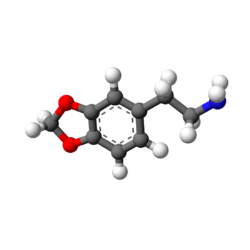3,4-Methylenedioxyphenethylamine
 | |
 | |
| Clinical data | |
|---|---|
| Pregnancy category |
|
| Routes of administration | Various |
| Legal status | |
| Legal status | |
| Pharmacokinetic data | |
| Bioavailability | ? |
| Metabolism | ? |
| Biological half-life | ? |
| Excretion | ? |
| Identifiers | |
| |
| Synonyms |
1,3-benzodioxolyl-5-ethanamine; 3,4-methylenedioxy-2-phenylethylamine |
| CAS Number |
1484-85-1 |
| PubChem (CID) | 73874 |
| DrugBank |
? |
| ChemSpider | 66508 |
| Chemical and physical data | |
| Formula | C9H11NO2 |
| Molar mass | 165.18914 g/mol |
| 3D model (Jmol) | Interactive image |
| |
| |
| (verify) | |
3,4-Methylenedioxyphenethylamine ("3,4-MDPEA" or just "MDPEA"), also known as homopiperonylamine, is a substituted phenethylamine formed by adding a methylenedioxy group to phenethylamine. It is structurally similar to MDA, but without the methyl group at the alpha position.
According to Alexander Shulgin in his book PiHKAL, MDPEA appears to be biologically inactive. This is likely because of extensive first-pass metabolism by the enzyme monoamine oxidase. However, if MDPEA were either used in high enough of doses (e.g., 1-2 grams), or in combination with a monoamine oxidase inhibitor (MAOI), it is probable that it would become sufficiently active, though it would likely have a relatively short duration of action. This idea is similar in concept to the use of selective MAOA inhibitors and selective MAOB inhibitors in augmentation of dimethyltryptamine (DMT) and phenethylamine (PEA), respectively.
In one known use of homopiperonylamine, amidation with 1-Adamantanecarbonyl chloride gives a dopamantane analog (Ex7).[2]
See also
References
- ↑ "Ustawa z dnia 15 kwietnia 2011 r. o zmianie ustawy o przeciwdziałaniu narkomanii ( Dz.U. 2011 nr 105 poz. 614 )". Internetowy System Aktów Prawnych. Retrieved 17 June 2011.
- ↑ U.S. Patent 3,944,675